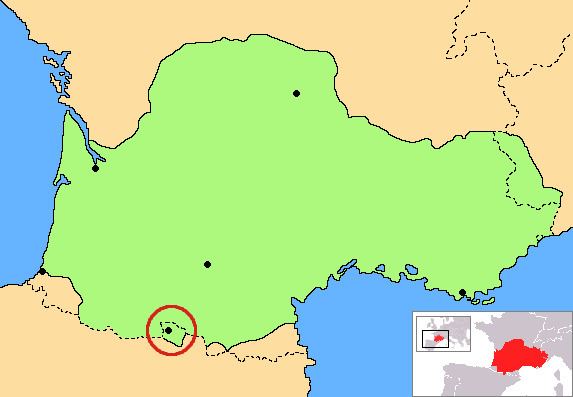Native speakers 4,700 (2001) | Glottolog aran1260 | |
 | ||
Language family Indo-EuropeanItalicRomanceGallo-RomanceOccitanGasconAranese | ||
Aranese (Occitan: Aranés) is a standardized form of the Pyrenean Gascon variety of the Occitan language spoken in the Val d'Aran, in northwestern Catalonia close to the Spanish border with France, where it is one of the three official languages beside Catalan and Spanish. In 2010, it was named the third official language of the whole of Catalonia by Parliament of Catalonia.
Contents
- Usage
- Phonology
- Consonants
- Diphthongs
- Loanwords
- Regulation
- Grammar
- Dictionaries
- Periodicals and commercial publications
- References
The official spellings of towns in Val d'Aran are Aranese; for example, the Aranese spelling Vielha is used on maps and road signs instead of the Catalan and Spanish Viella.
Usage
According to a 2001 linguistic census by the Aranese government, about 90% of the inhabitants of Val d'Aran can understand the language, with those between 25 and 34 years old having the lowest rate, at around 80% (excluding those under the age of 4). Between 60 and 65% of the population can speak it; however, only 26% reported being able to write in Aranese.
In 2008, the Generalitat of Catalonia surveyed the population (15 years old or older) in the Val d'Aran. The survey reported that 78.2% of the population could understand Aranese, 56.8% could speak it, 59.4% could read it, and 34.8% could write the language.
Once considered to be an endangered language spoken mainly by older people, it is now experiencing a renaissance; it enjoys co-official status with Catalan and Spanish within Val d'Aran, and since 1984 has been taught bilingually alongside Castilian in schools. Students in the Val d'Aran are required to have 2 hours of each Spanish, Catalan, and Aranese each week. At some levels of education, a foreign language is added to the three official languages—usually French due to proximity—and sometimes even 2 additional hours of English.
Phonology
General Gascon characteristics:
Specific Aranese characteristics:
Consonants
Notes:
- The voiced stops /b/, /d/, /ɡ/ are devoiced to /p/, /t/, /k/, respectively, in word-final position.
- /h/ is pronounced oy in the towns of Bausen and Canejan. Foreign words that have not been adopted into Aranese also retain /h/: hardware, maharajah.
- /ɾ/ is pronounced [ɾ], except at the end of a word, where it is generally silent, regardless of what follows.
Diphthongs
Notes:
- In practice, stressed ei tends to be pronounced [e]: trueita pronounced as trueta.
- Word-final èi is often pronounced [ɛ] instead of [ɛj]: cantèi pronounced as cantè. Similarly, speakers tend to say òu as ò [ɔ]: auriòu is pronounced like auriò
- iu can be pronounced as [iw] or [jew]: Diu [diw ~ djew]
- Orthographic ui historically was a diphthong, but is currently produced as [y].
Aranese orthography denotes where two consecutive vowels do not diphthongize, but rather form a hiatus.
Loanwords
Since the Val d'Aran is located within Spanish and Catalan territory, Aranese is subject to certain influences from Castilian Spanish and Catalan. As such, Aranese has adopted several neologisms from them:
Spanish and Catalan have also created deformations of words such as abans > abantes or dempús > despuès. Some Hispanicisms are directly adopted into Aranese: hasta.
Regulation
Aranese is regulated under classic unifying standards of Occitan, defined initially by Loís Alibèrt. These standards of the Conselh de la Lenga Occitana (Occitan Language Council) have officially been recognized by the Conselh Generau d'Aran (General Council of Aran) since 1999.
In practice, several details standards diverge due to the popular or preferred usage of Aranese, in relation to other Gascon varieties. For instance:
Grammar
A reference on usage and conjugation of Aranese verbs entitled Es Vèrbs conjugadi : morfologia verbau aranesa was written by Verònica Barés Moga and published in 2003. A descriptive and normative reference grammar book, written in Aranese by Aitor Carrera, was published in March 2007. It includes a detailed breakdown of phonological and grammatical differences between varieties of Aranese in different villages in the valley.
Dictionaries
A dictionary of Aranese was written by the Catalan linguist Joan Coromines as his doctoral thesis.
A simple four-language Spanish–Aranese–Catalan–French dictionary exists, written by Frederic Vergés Bartau (see Bibliography).
An Aranese-English and English–Aranese dictionary was published in 2006. It was written by Ryan Furness, a young man from Minnesota, after he became curious about the language when he traveled to Val d'Aran.
A detailed one-volume Catalan–Occitan and Occitan–Catalan dictionary was published under the auspices of the governments of Catalonia (Generalitat de Catalunya) and Val d'Aran (Conselh Generau d'Aran). Although it calls the language "Occitan", it uses Aranese spelling and its preface says that special attention is given to the Aranese variety.
Periodicals and commercial publications
A local monthly magazine Toti and local newspapers are published partly in the language.
